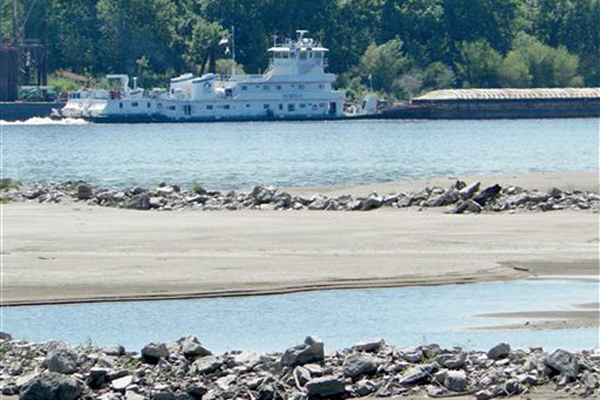Story by Adrian Sainz, Associated Press
Photo courtesy of Google Images
(MEMPHIS, Tenn.) — Low water levels that are restricting shipping traffic, forcing harbor closures and causing barges to run aground on the economically vital Mississippi River are expected to continue into October, U.S. Army Corps of Engineers officials said Tuesday.
Meanwhile, more than 100 tow boats and barges remain backed up near Greenville, Miss. due to the low river. The U.S. Coast Guard opened an 11-mile stretch of river that had been closed near Greenville, replacing it with a 5-mile zone where only lighter vessels can pass.
Speaking at a meeting of Corps officials, water control managers and business people in Memphis, Major Gen. John W. Peabody said that five harbors — in Tennessee, Missouri, Arkansas and Mississippi — are closed, and several others have limited access due to low water levels along the nation’s most important inland waterway.
Peabody, commander of the Corps’ Mississippi Valley Division, said the Corps plans to dredge those harbors as soon as it can to allow tow boats and barges to enter and get close enough to docks to unload their materials. Farms and other businesses rely on materials such as grain, feed and fuel that usually arrive by barge to smaller harbors.
The Corps continues to dredge the river’s navigation channel, making sure it is deep enough to allow barges to pass safely. Dredges are currently working on the navigation channel in Greenville and near Memphis, officials said.
Peabody said he receives reports of vessels running aground on a daily basis. He also says that river levels will likely remain low into October, which is typically when levels are the lowest each year.
“The worst is ahead of us,” Peabody said.
The Mississippi River from Illinois to Louisiana has seen water levels plummet due to drought conditions in the past three months. Near Memphis, the river level was more than 12 feet lower than normal for this time of year.
Shippers that haul goods on barges pulled by tow boats have had to lighten their loads to avoid running aground, resulting in a loss in revenue. Shippers also face higher costs that emerge when they have to fix grounded vessels.
George Leavell, executive vice president of Wepfer Marine Inc., said one barge is currently stuck in the harbor in Osceola, Ark., and he needs the Corps to dredge the harbor to get it out.
Leavell, whose Memphis-based company conducts tow operations in Mississippi River harbors, said the vessel ran aground on a shoal that had accumulated during last year’s flood, which pushed sediment into many harbors. The river in Memphis is more than 55 feet lower than its near-record peak of 48.03 feet on the Memphis gauge last May.
In addition to Osceola, other harbors and ports that have been closed are the Northwest Tennessee port, New Madrid County harbor in Missouri, Helena and Phillips County harbors in Arkansas, and the Claiborne County port near Vicksburg, Miss.
With those harbors closed, farmers and truckers are incurring higher transportation costs because they have to drive longer distances to get their materials at harbors that are open. Also, because barge operators have had to lighten their loads, some farmers have or will be having trouble getting their goods to market.
Leavell estimates that the closure of the Osceola harbor alone could cost the shipping industry hundreds of thousands of dollars.
“A lot of these smaller communities are very dependent on these ports for their economies,” Leavell said.
Leavell and Corps officials noted that Congress has cut funding for dredging over the past few years. The Corps is actually relying on supplemental funds awarded to the Corps for flood recovery to help manage the low water levels, Peabody said.
“A lot of the ports on the lower Mississippi River are in really bad shape,” Leavell said.
The river level in Memphis was minus-8.7 feet on Tuesday, according to the National Weather Service. The “minus” reading does not mean the river is dried up — it’s just a measurement based on how the Memphis river gauge is designed. Essentially, the reading means the river level is far below normal.
The record for the lowest measured water level for the Mississippi River near Memphis is minus-10.7 feet, in 1988. A paper published in the Bulletin of the American Meteorological Society in September 1989 estimated that the drought caused the U.S. barge industry to suffer total losses of about $1 billion that year
In past weeks, the Corps projected that the river would likely fall to about 1 foot of the record. Should the drought persist, it could turn out to be a closer call than first imagined
Col. Vernie L. Reichling Jr., commander of the Corps’ Memphis division, said: “We are on a path, if no rain arrives, to hit that historical low.”


